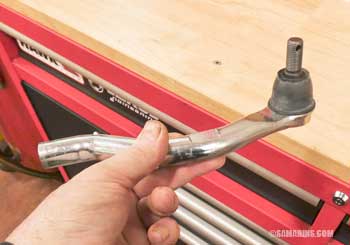Outer Tie Rod End: how it works, symptoms, problems, replacement cost
By Vlad Samarin May 14, 2023
 Outer tie rod end.
See a larger photo
Outer tie rod end.
See a larger photoThere are two outer tie rod ends (left and right) in a car. Their function is to transfer the steering rack movement to the front wheels, allowing the driver to steer, see the diagram.
An outer tie rod end consists of a ball joint with a threaded stud on one end, and a sleeve with internal threads on the other end. The ball joint connects to the steering knuckle while the sleeve is attached to the inner tie rod end of the steering gear. The ball joint is greased inside and is protected by a rubber boot.
As the steering wheel is turned, the steering gear (steering rack) moves the outer tie rod ends left or right, turning the front wheels.
Outer tie rod end problems
We see problems with outer tie rod ends in all cars, especially at higher mileage. Over time, outer tie rod ends can wear out, resulting in excessive play or looseness in the ball joints. This compromises the handling and safety of the vehicle. An outer tie rod end can also get bent or damaged in an accident or if the vehicle hits the curb with one of the front wheels.Is the vehicle with a bad outer tie rod end safe to drive? No, if the outer tie rod end is loose or damaged, the vehicle is considered unsafe to drive. A loose outer tie rod end can separate which will result in loss of the steering function.
For this reason it is important to have the tie rod ends and other parts of the steering and suspension of your car inspected regularly. Bad outer tie rod ends must be replaced.
Your mechanic may also recommend replacing the outer tie rod end if its rubber boot is broken even though there is no looseness at the moment. This is because once the rubber boot is broken, it won't take long for water to get inside and cause the ball joint to rust resulting in the outer tie rod end failure.
Symptoms of a bad tie rod end
A bad outer tie rod end can cause looseness (excessive play) felt in the steering as well as a rattling or knocking noise coming from the front end or the steering when driving slowly over rough surface. However, often a bad outer tie rod end will not show any symptoms. That's why we recommend having your vehicle's steering, suspension and brakes regularly inspected by a qualified mechanic.How do mechanics test tie rod ends?
Loose Outer Tie Rod End.
When the vehicle is raised on the hoist, a loose tie rod end feels like excessive play in front wheel when pushing it in the direction of left or right turn. Mechanics also check the physical condition of outer tie rod ends and their rubber protective boots. If the tie rod end rubber boot is damaged, water will get in and cause the tie rod end ball joint to rust.
Outer tie rod end replacement cost
Replacing one outer tie rod end in an average car will cost you 0.5-0.7 hours of labor plus the cost of the part ($30-$60).Advertisement
It's not necessary to replace both left and right outer tie rod ends if only one is bad. However, it makes sense if the second outer tie rod end looks old or shows signs of wear.
Is it difficult to change the outer tie rod end DIY? No, it's not very difficult, however the wheel alignment needs to be done after the replacement. So, it makes more sense to have it changed at the same shop where you are going to get the wheel alignment done.
Does the outer tie rod end need to be greased? Only if it has a grease fitting. In most modern cars, outer tie rod ends are sealed and don't need any maintenance. In some trucks, the outer tie rod ends do have grease fittings and must be greased regularly. Some aftermarket outer tie rod ends also come with grease fittings and need to be greased.
